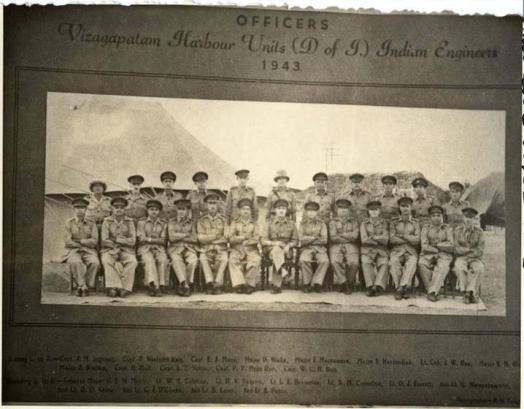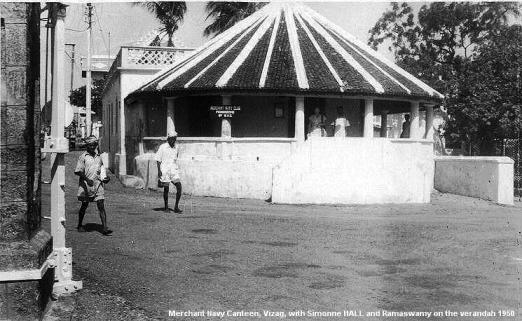Fond Memories of India
Category:

Rodney trained for a nautical career at HMS Conway in Anglesey and joined the Cunard Line in 1958. He went on to command various vessels around the world until his retirement in 1993. He lives in the UK.
Editor's note: This article is an expanded version of My First School Days, which is available at http://rmhh.co.uk/ooty.html.
I was born in 1940 in Vizagapatam (shortened to Vizag, now called Vishakapatnam), on the Bay of Bengal.

My father was then the chief pilot in that port, and he went on to become Harbourmaster. However, my story in India really goes back to 1906, when my paternal grandfather, Harry Hall, came to Calcutta to bring Pathé News ( Ed: Pathé News produced newsreels, which were shown in cinema halls.) to India for the Pathé Frères, whom he knew from his days in Paris. With him, he brought his wife, Suzanne and his 5 year old son, Herbert, my father. This was Herbert's introduction to India.

When Herbert left school back in England, he went to a Nautical training ship before joining T&\;J Harrison's shipping company as a navigating cadet and later, officer. During the Depression, it was almost impossible to obtain promotion, so Herbert joined the Scindia Company. In 1934, Hebert took the opportunity to come ashore as Dredging Master in the port of Vizagapatam, where amongst other things, he constructed the breakwater at the entrance to Vizag harbour.

Herbert brought out his wife Simonne, my mother, and moved into "Shamrock Villa" on Beach Road, built by Cornelius Riordan in about 1865.


Herbert then left his post as Dredging Master to become one of the port Pilots, later becoming Senior Pilot, then Harbourmaster.
He had a house built in Gokhale Road, Maharanipetta, and called it "Shiva Prasad". That was my birthplace.

 When my father became Harbour Master, we moved nearby into the ‘Port Officer's Bungalow', where we lived until we left India in 1950.
When my father became Harbour Master, we moved nearby into the ‘Port Officer's Bungalow', where we lived until we left India in 1950.
During WWII, the Vizag Harbour Indian Engineers Unit was formed, and my father joined as Captain. During the war, there was considerable Japanese submarine activity outside Vizag and the harbour was repeatedly bombed. The harbour was an important target due to the export of manganese ore and the building of ships in Scindia's yard. My father and other members of the Harbour Unit set up posts amongst the trees on the Dolphin's Nose hill at the harbour entrance and with their .303 rifles picked off many of the Japanese bomber pilots as they flew low to bomb the port - they never knew what hit them! We had an anti-aircraft gun in the corner of our compound at the Port Officer's Bungalow, but I don't know if we got any aircraft with it.
Meanwhile, my mother, Simonne, was busy with the Women's Voluntary Service (WVS) which in 1943 established a Canteen alongside Mosin's Stores in Vizag, for visiting ship's crews. This later became too ‘hot' to handle for the ladies and my father took it over pro-bono and it became the Merchant Navy Club. Dad used to go to Delhi to obtain films for showing in the open air at the back of the Club, with the films projected onto the side wall of Mosin's Stores.



Due to the summer heat in the plains of India, Europeans usually sent their children to "the hills" for schooling, where the climate was more like that of England, and thus where the British schools were built. My sister Kathleen, who was born Liverpool in 1927, went to a girls' boarding school in Darjeeling, in the foothills of the Himalayas (St. Michael's) from 1936 to 1939 and then to Nazareth Convent in Ootacumund (Ooty) from 1940 to 1943 before joining the Women's Royal Indian Naval Service (WRINS) and then going to college in England after the war.
 My first school days were in Ooty at the Breeks Memorial Boarding School, 1945-1950. It took nearly three days on the Bengal Nagpur Railway - BNR - from home in Vizag to reach Ooty, stopping in Madras to change trains. While we waited for the connection, we all went to the zoo. The latter part of the journey from Mettupalayam to Ooty was by rack and pinion railway, the Nilgiri Mountain Railway. The railway has recently gained World Heritage status. Opened in 1908, it climbs 4,000 feet from Mettupalayam to Ootacumund (known to us in those days as "Snooty Ooty"). The line has more than 250 bridges and 16 tunnels. The line's steam locomotives date from 1914 and were made in Switzerland. The line featured in the 1984 film "Passage to India". The journey was slow enough (it took five hours) to be able to leave the train and re-join further up the hill. Monkeys would frequently come through the open carriages and raid any food you might be eating! I have particular memories of a wonderful Miss Reeves and a feared Miss Chaves at Breeks!
My first school days were in Ooty at the Breeks Memorial Boarding School, 1945-1950. It took nearly three days on the Bengal Nagpur Railway - BNR - from home in Vizag to reach Ooty, stopping in Madras to change trains. While we waited for the connection, we all went to the zoo. The latter part of the journey from Mettupalayam to Ooty was by rack and pinion railway, the Nilgiri Mountain Railway. The railway has recently gained World Heritage status. Opened in 1908, it climbs 4,000 feet from Mettupalayam to Ootacumund (known to us in those days as "Snooty Ooty"). The line has more than 250 bridges and 16 tunnels. The line's steam locomotives date from 1914 and were made in Switzerland. The line featured in the 1984 film "Passage to India". The journey was slow enough (it took five hours) to be able to leave the train and re-join further up the hill. Monkeys would frequently come through the open carriages and raid any food you might be eating! I have particular memories of a wonderful Miss Reeves and a feared Miss Chaves at Breeks!
The school year then consisted of two terms with two months holiday at Christmas and a short break for summer. I cannot recall how long that was, but it was too short to make it practical for the journey home, and in any case the summer heat in the plains was against it, so I stayed with family missionary friends, the Gullisons, in Ooty. So went my first five years of schooling until 1950.
The family returned to England in 1950. My father had been asked by the Indian Government to remain after Independence in 1947, to make a smoother handover to a new Indian Harbourmaster in Vizag. We said goodbye to Vizag with my father making his last piloting passage when we sailed on the "City of Oxford". He went on to take up a post setting up a Merchant Navy Hotel in Cardiff, Wales, from where he went on to set up two Merchant Navy Clubs in New York, where he remained until his retirement in 1968 at the age of 67.

For many years after leaving India we received - and sent - cards and gifts to many of our old domestic and business staff in Vizag and Ooty.
Epilogue
Today, I cannot now remember a lot of Telugu, although it was really my first language, due to Ayah! I do remember, however, an instance in the early 1960's when I cleared a long queue at a London post office by translating for a Telugu at the head of the queue who was trying to wire money home. The looks I got were amazing - and I got to finish my own business at the same time! I had planned to visit Vizag and Ooty with my sister in 2005 but sadly she died just before Christmas 2003. Memories will have to do.
The Editor has asked my whether I have any memories of Independence Day, 15 August 1947. I'm afraid I don't. Nor was this day something my parents discussed within the family later on. I do know that in 1950 we were all sad to leave India, which we considered our home, for England. I was a little less than enthusiastic about England as my only previous experience was the severe winter of 1946 when we went on ‘home leave' for 6 months. It was the first time I had been out of India and I was not impressed with the cold weather!
© Rodney Hall 2011
Add new comment